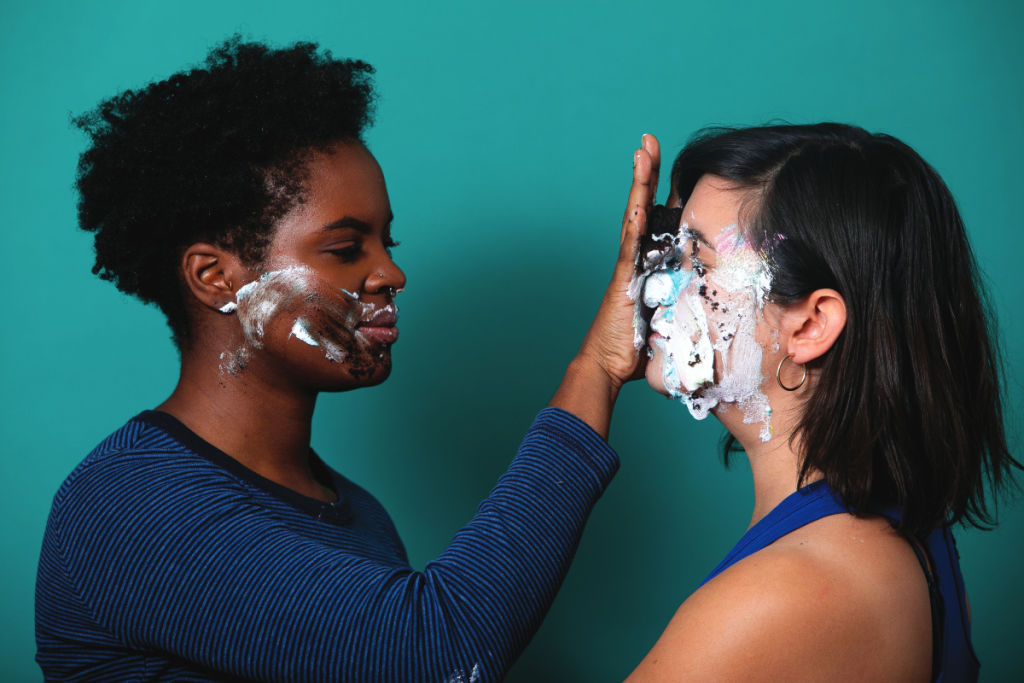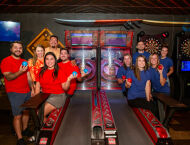Culture
 darlingdance. Photo by Mariah Miranda.
darlingdance. Photo by Mariah Miranda.
Six Dance Companies to Know
September 1, 2022 @ 12:00pm
This piece is part of our Performing Arts Guide in the September 2022 print issue of District Fray.
S. J. Ewing & Dancers
Dance starts out logical: Move your right arm here. Put your left there.
“But when all those pieces are put together and you see a performer on stage, it’s magic,” Sarah J. Ewing says.
Making beauty from logic is at the heart of S. J. Ewing & Dancers, the D.C.-based company Ewing directs. The company combines dance and tech. In some performances, algorithms create motion-activated projections in live time based on the dancers’ movements. Other times, audiences watch the dancers in virtual reality. Performers and computers alike take step-by-step instructions and transform them on stage.
Back when Ewing worked for CityDance, she did data management as part of her job. Mapping out the back end of a database, she realized figuring out where to store data felt similar to figuring out how to choreograph a dance. So about six years ago, she started trying to combine the two with motion-tracking projection.
Since then, she’s brought on another designer and programmer, Dylan Uremovich, as well as sound designer Jade Diouf and videographer Jonathan Hsu. Together with dancers, they create fusions of human and algorithmic brilliance.
One of Ewing’s favorite memories revolves around a redevelopment of the company’s first projection piece. As dancers moved, Uremovich’s projected grid expanded and pulled and transformed around their feet.
“In some ways, this floor projection was able to capture some of the magic that lives outside of their bodies that they are creating,” Ewing says. “And I just found that to be just so, so beautiful.”
S. J. Ewing & Dancers’ new VR films will be presented by CityDance on November 12 and 13.
darlingdance
Hayley Cutler, founder and artistic director of darlingdance, doesn’t want her dancers to look untouchable or ethereal. She doesn’t want to see them floating through the air. Instead, they’re human. They’re pedestrian. They pace on stage eating pizza and call it dance.
“We’re taking up space in a field that doesn’t want a range of women — or a range of bodies — to [do so],” Cutler says.
darlingdance began in 2010 with the goal of exposing audiences to the reality of the body. The company aims to create space in dance for performers with different bodies and styles of dance — ones that haven’t always been accepted on stage.
The company’s works are all products of collaboration. For instance, one dancer was struggling to pronounce “foie gras” during a friendly conversation. Later, when the company wanted a two-syllable phrase to fit the rhythm of a dance, “foie gras” worked its way into performance.
The group’s upcoming piece “All My Friends” is built off dancers’ feelings. They began practice by figuring out where they felt cozy on The Kennedy Center’s REACH campus, then explored where they felt uncomfortable and how to channel these feelings into movement.
“There’s a range of aesthetics and movement styles I’m interested in that are rooted in diversity,” Cutler says. To Cutler, body diversity is “both the most important thing and the thing I don’t think about because it’s just how life is.”
darlingdance’s performance “All My Friends” premieres at The Kennedy Center’s REACH campus on September 17. Audiences will be encouraged to move through the space. Seating will be limited but available upon request.
darlingdance.com // @darlingdanceco
Ngoma Center for Dance + Dissonance Dance Theatre
In 2018, Dissonance Dance Theatre performed for an audience of more than 1,000 at the Association of Performing Arts Professionals (APAP).
“To be the D.C. ambassador at APAP was a nervous affair at first,” writes producing artistic director and principal choreographer Shawn Short. “But watching my dancers, many of whom I’ve had for several years (street to the stage), glow on stage with great performance quality was a touching moment.”
Dissonance Dance Theatre is the only nationally recognized contemporary ballet company in the mid-Atlantic area founded by African American leaders, according to Short. The Ngoma Center for Dance, its parent company, aims to offer a space for multicultural dancers and their enthusiasts; Short is the Center’s founding director.
“To be simple, I believe the mission is equity and access for a non-performative reality,” Short says. “We practice what we preach.”
Though Covid forced a temporary halt, Dissonance Dance Theatre will return to in-person programming in March 2023. It’s also currently working on a documentary, “Company D,” about the racism, adversity and pandemic problems Dissonance fought through to create a space for Black classical and contemporary dancers.
Mentoring new dancers is a critical part of Short’s mission. One of his favorite memories from Ngoma and Dissonance is adjudicating The International Association of Blacks in Dance, where he says Dissonance and Ngoma offered scholarships and contracts to more than 60 young artists.
“Seeing the faces of so many dancers wanting an opportunity really humbles a person, ya know? Many people have aided me in my development, and I believe it is my prerogative to give back whenever I can.”
Dissonance Dance Theatre returns for in-person performances March 2023.
Dance Place
Dance Place is all about community, as far as its new artistic director is concerned.
dani tirrell is approaching one year at Dance Place. Looking back at successes like DanceAfrica DC 2022, and forward to upcoming performances by local artists, tirrell is trying to figure out what perspectives and ideas to bring to the 44-year-old company.
“What I’m coming in with is just really my love for community and people,” tirrell says. “Everything I do is seen through the lens of Black liberation and Black feminist theory. For me, those things also open up [so] that other people can come into the space.”
tirrell focuses on making space for new artists. Whether by offering more residencies or creating space for people to work without pressure, tirrell wants to figure out how to support dancers in a low-stress environment.
Uninterested in conforming to traditional dance norms, tirrell makes room for artists’ full selves: for everyone’s distinctive rhythms and fashion and language.
It all ties back to tirrell’s vision of dance, filtered through the lens of Black liberation.
“It looks like flowers, it looks like roses, it looks like joy,” tirrell says. “It looks like a space where people can breathe — a space where Black bodies don’t have to apologize.”
Dance Place will host Kinetic Light for a performance September 24 and 25. Local artists Sarah Beth Oppenheim, Charlie Maybee and Chitra Subramanian will be presented by Dance Place this fall.
3225 8th St. NE, DC; danceplace.org // @danceplacedc
Solas Nua’s “Yes and Yes” with Liz Roche Company
Got any plans for celebrating the 100th anniversary of James Joyce’s “Ulysses”? No? Well then, it’s a good thing Irish arts group Solas Nua has you covered.
To commemorate the first time “Ulysses” was published as a full volume, Solas Nua commissioned Liz Roche Company to create “Yes and Yes,” a new dance performance in response to the novel. Liz Roche, an Irish choreographer, will bring her company to D.C. for the September premiere.
Dublin is at the center of both “Ulysses” and the new performance.
“Joyce famously said when he wrote ‘Ulysses’ that if Dublin was destroyed, you could rebuild the city based on the book,” says Miranda Driscoll, executive director of Solas Nua. “So basically [Roche is] really looking at the city of Dublin and what ‘Ulysses’ means, 100 years later, through the [human] body.”
The performance gets its name from the last chapter of “Ulysses,” which begins and ends with the word “yes.” But despite all the inspirations “Yes and Yes” takes from the novel, Driscoll wants everyone — regardless of their “Ulysses” knowledge — to come see the dance.
“You don’t have to be a ‘Ulysses’ expert,” Driscoll says. “You don’t even have to read ‘Ulysses.’ It’s a piece within its own right.”
DMV residents can see “Yes and Yes” on September 9 and 10 at the Atlas Performing Arts Center.
Atlas Performing Arts Center: 1333 H St. NE, DC; atlasarts.org // @atlaspacdc
Solas Nua: solasnua.org // @solasnua_
Carpathia Folk Dance Ensemble
By July 1, Carpathia Folk Dance Ensemble eclipsed the number of performances it typically does in a year. That’s because the ensemble was fundraising to support Ukraine. The multi-ethnic group’s usual mission is to preserve and present Central European dance — but Carpathia’s artistic director and founder Wesley Reisser says the Russian invasion of Ukraine transformed his goals.
“We’re now heavily involved in raising awareness and support for Ukraine,” he says. “Also, awareness and support for all the countries nearby taking in refugees.”
While the group performs at festivals up and down the East Coast, it isn’t exclusive to professionals. Carpathia welcomes pretty much everyone who wants to join: Requirements are just being at least 14 years old and interested in joining a performance group.
Performing dances from such a wide range of regions means dancers must learn a huge mix of moves and rhythms. But at its heart, the troupe’s fast-paced dances are uplifting, all about expressing joy and sharing with the audience.
Reisser says Ukrainian dance is frequently a fan favorite, full of vibrant movement.
“The guys are doing squats and kicks on the floor and the women are doing these really fast, crazy turns in costumes with tons of ribbons,” Reisser says. “They look like streak of colors just going across the stage.”
Carpathia Folk Dance Ensemble will perform on September 10 and 11 at the Baltimore Ukrainian Festival in Baltimore, Maryland and on October 1 at the St. Matthew Festival in Columbia, Maryland.







